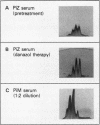Abstract
Individuals with serum α1-antitrypsin levels below 80 mg/dl are clearly at risk for the development of accelerated panacinar emphysema. One possible approach to the therapy of this disorder would be to raise serum levels of this major antiprotease to establish protease-antiprotease homeostasis within the lung parenchyma. Because danazol, an impeded androgen, elevates levels of C1 inhibitor in patients deficient of that serum antiprotease, we hypothesized that this agent might also increase α1-antitrypsin levels in patients with α1-antitrypsin deficiency. To evaluate this concept, seven patients with severe emphysema associated with α1-antitrypsin deficiency (six PiZ and 1 MDuarteZ) and one asymptomatic individual (PiSZ) received 600 mg of danazol daily for 30 d. Five of the six PiZ patients responded to danazol therapy with significant increases in serum α1-antitrypsin levels (mean increase of 37%; P < 0.03). The two individuals who were heterozygous for the Z protein increased their serum levels by 85% (PiMDuarteZ) and 87% (PiSZ), respectively. These increases in serum α1-antitrypsin antigen were accompanied by commensurate increases in serum trypsin inhibition. Crossed immunoelectrophoresis showed no alterations of the microheterogeneity of the α1-antitrypsin or the presence of protease-antiprotease complexes in serum during danazol therapy. These data demonstrate that serum α1-antitrypsin levels can be augmented by danazol therapy in PiZ individuals as well as those heterozygotes with severe deficiency of α1-antitrypsin. The clinical relevance of these increases in serum α1-antitrypsin remains speculative, but these findings suggest that danazol may provide a means of improving the protease-antiprotease balance in these individuals and thus impede the progression of their lung disease.
Full text
PDF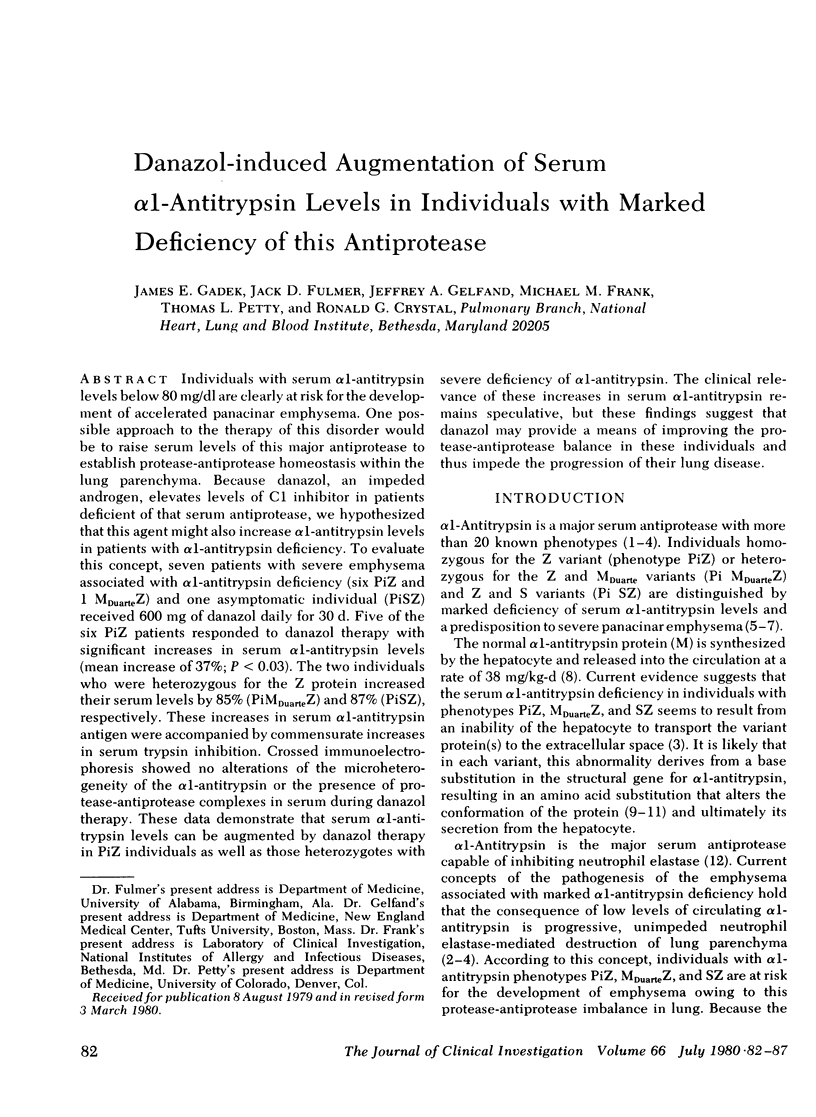
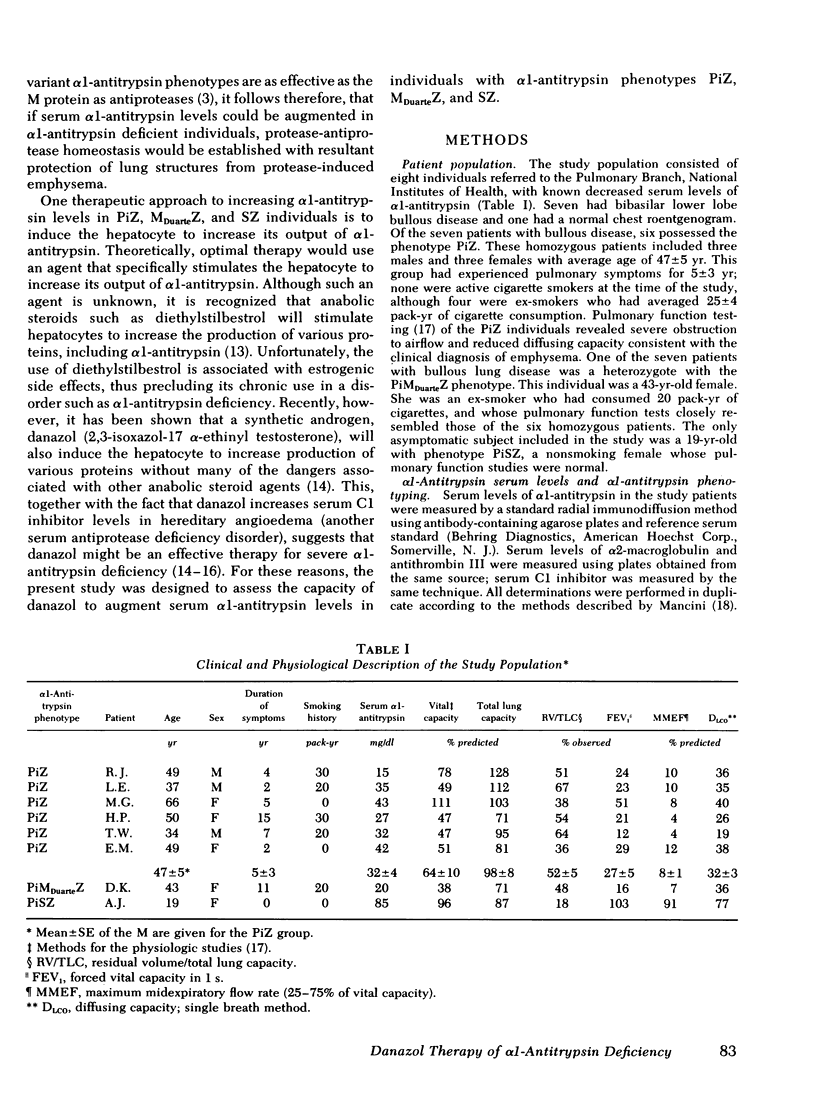
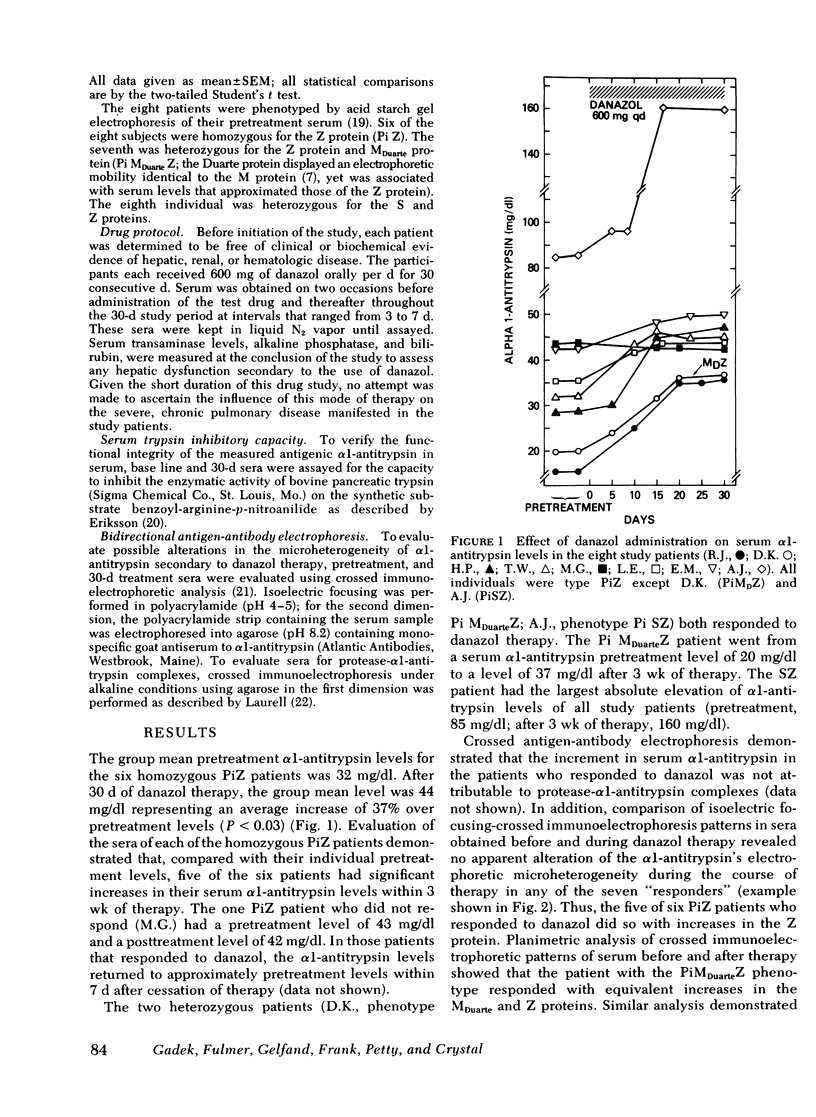
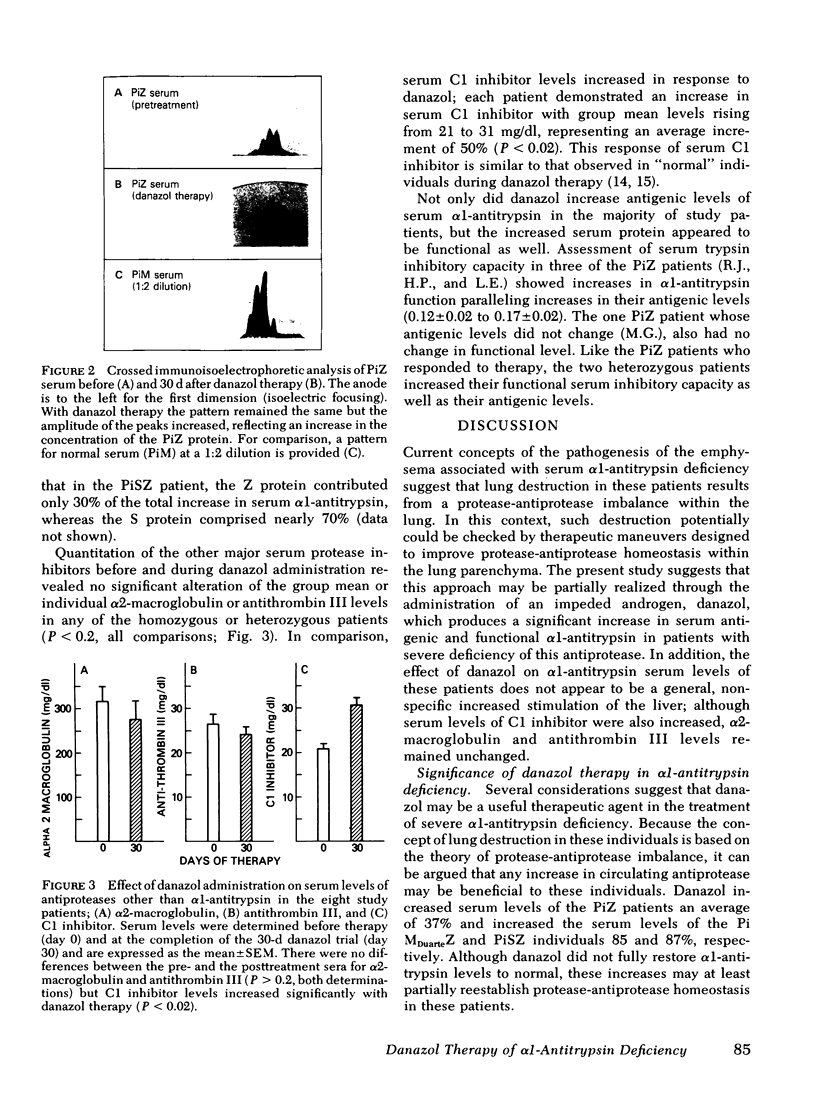
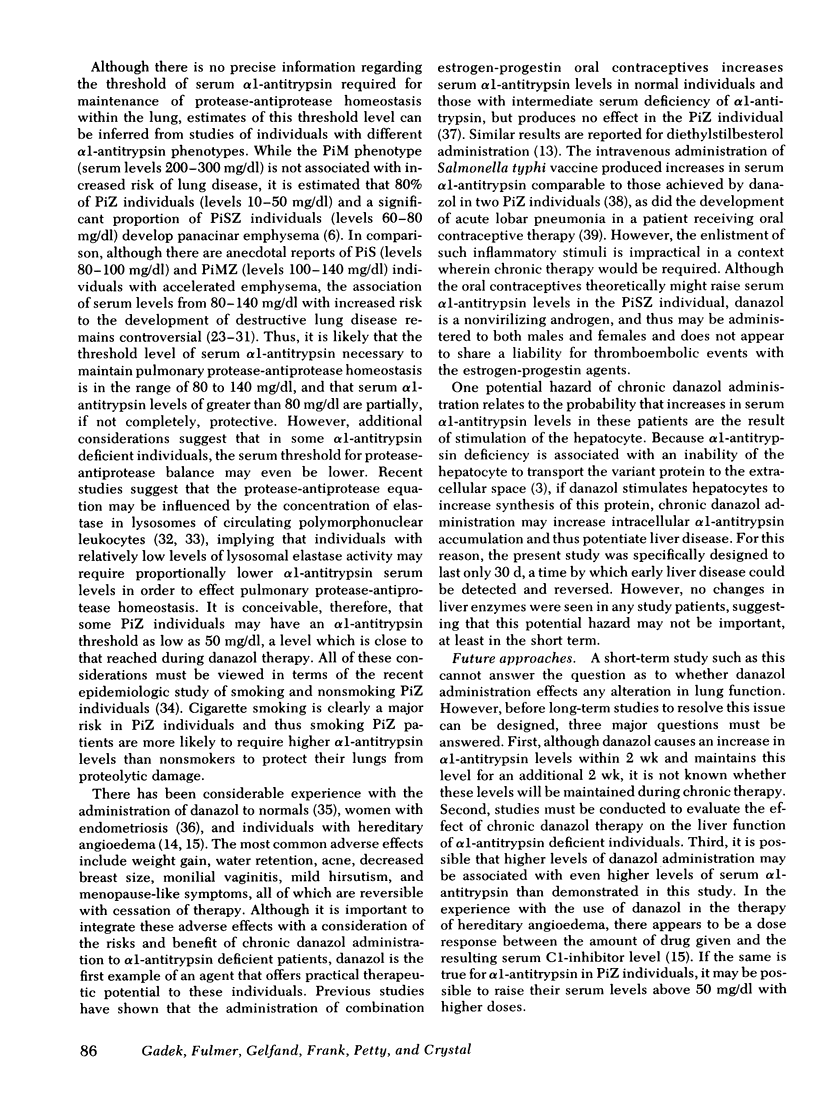
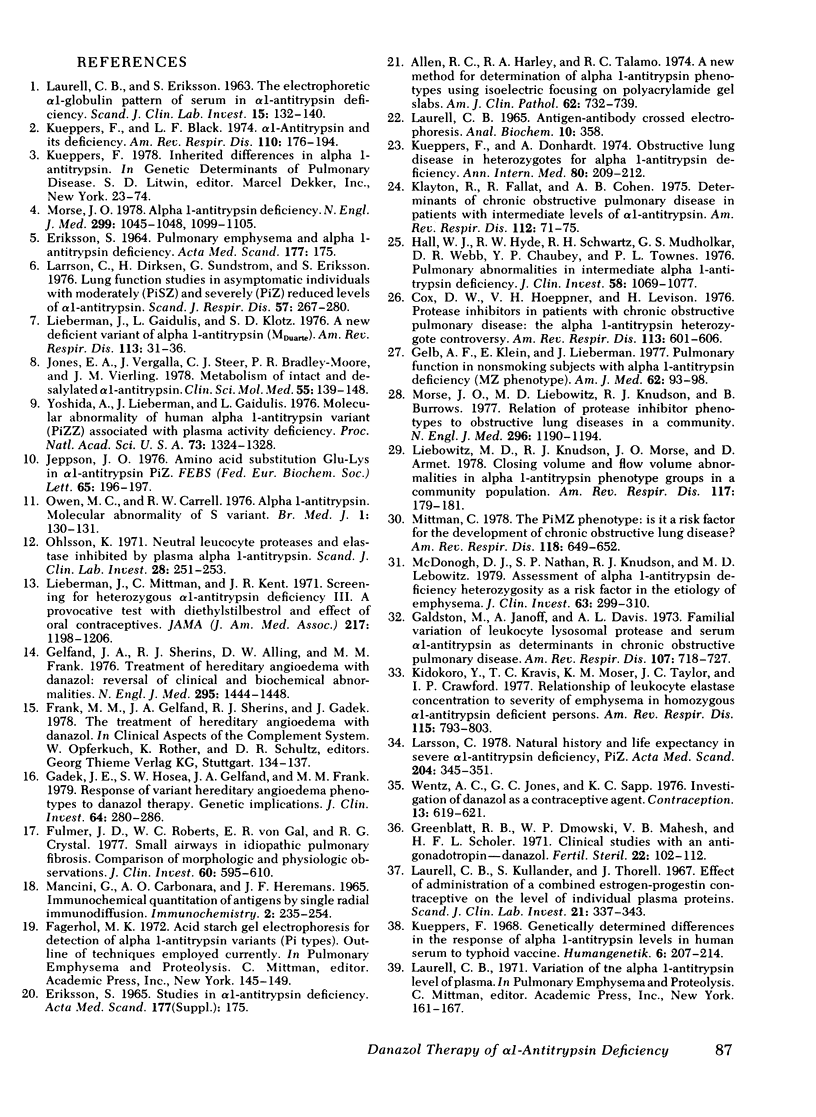
Images in this article
Selected References
These references are in PubMed. This may not be the complete list of references from this article.
- Allen R. C., Harley R. A., Talamo R. C. A new method for determination of alpha-1-antitrypsin phenotypes using isoelectric focusing on polyacrylamide gel slabs. Am J Clin Pathol. 1974 Dec;62(6):732–739. doi: 10.1093/ajcp/62.6.732. [DOI] [PubMed] [Google Scholar]
- Cox D. W., Hoeppner V. H., Levison H. Protease inhibitors in patients with chronic obstructive pulmonary disease: the alpha-antitrypsin heterozygote controversy. Am Rev Respir Dis. 1976 May;113(5):601–606. doi: 10.1164/arrd.1976.113.5.601. [DOI] [PubMed] [Google Scholar]
- Fulmer J. D., Roberts W. C., von Gal E. R., Grystal R. G. Small airways in idiopathic pulmonary fibrosis. Comparison of morphologic and physiologic observations. J Clin Invest. 1977 Sep;60(3):595–610. doi: 10.1172/JCI108811. [DOI] [PMC free article] [PubMed] [Google Scholar]
- Gadek J. E., Hosea S. W., Gelfand J. A., Frank M. M. Response of variant hereditary angioedema phenotypes to danazol therapy. Genetic implications. J Clin Invest. 1979 Jul;64(1):280–286. doi: 10.1172/JCI109449. [DOI] [PMC free article] [PubMed] [Google Scholar]
- Galdston M., Janoff A., Davis A. L. Familial variation of leukocyte lysosomal protease and serum 1 -antitrypsin as determinants in chronic obstructive pulmonary disease. Am Rev Respir Dis. 1973 May;107(5):718–727. doi: 10.1164/arrd.1973.107.5.718. [DOI] [PubMed] [Google Scholar]
- Gelb A. F., Klein E., Lieberman J. Pulmonary function in nonsmoking subjects with alpha1 antitrypsin deficiency (MZ phenotype). Am J Med. 1977 Jan;62(1):93–98. doi: 10.1016/0002-9343(77)90354-0. [DOI] [PubMed] [Google Scholar]
- Gelfand J. A., Sherins R. J., Alling D. W., Frank M. M. Treatment of hereditary angioedema with danazol. Reversal of clinical and biochemical abnormalities. N Engl J Med. 1976 Dec 23;295(26):1444–1448. doi: 10.1056/NEJM197612232952602. [DOI] [PubMed] [Google Scholar]
- Greenblatt R. B., Dmowski W. P., Mahesh V. B., Scholer H. F. Clinical studies with an antigonadotropin-Danazol. Fertil Steril. 1971 Feb;22(2):102–112. doi: 10.1016/s0015-0282(16)38045-1. [DOI] [PubMed] [Google Scholar]
- Hall W. J., Hyde R. W., Schwartz R. H., Mudholkar G. S., Webb D. R., Chaubey Y. P., Townes P. L. Pulmonary abnormalities in intermediate alpha-1-antitrypsin deficiency. J Clin Invest. 1976 Nov;58(5):1069–1077. doi: 10.1172/JCI108558. [DOI] [PMC free article] [PubMed] [Google Scholar]
- JEZEK V., OUREDNIK A., DAUM S., KROUZKOVA L. EFFECT OF SHORT-TERM HYPOXAEMIA ON THE POTASSIUM AND SODIUM METABOLISM AND ON CARDIAC CONTRACTION. Acta Med Scand. 1965 Feb;177:175–182. doi: 10.1111/j.0954-6820.1965.tb01820.x. [DOI] [PubMed] [Google Scholar]
- Jones E. A., Vergalla J., Steer C. J., Bradley-Moore P. R., Vierling J. M. Metabolism of intact and desialylated alpha 1-antitrypsin. Clin Sci Mol Med. 1978 Aug;55(2):139–148. doi: 10.1042/cs0550139. [DOI] [PubMed] [Google Scholar]
- Kidokoro Y., Kravis T. C., Moser K. M., Taylor J. C., Crawford I. P. Relationship of leukocyte elastase concentration to severity of emphysema in homozygous alpha1-antitrypsin-deficient persons. Am Rev Respir Dis. 1977 May;115(5):793–803. doi: 10.1164/arrd.1977.115.5.793. [DOI] [PubMed] [Google Scholar]
- Klayton R., Fallat R., Cohen A. B. Determinants of chronic obstructive pulmonary disease in patients with intermediate levels of alpha-antitrypsin. Am Rev Respir Dis. 1975 Jul;112(1):71–75. doi: 10.1164/arrd.1975.112.1.71. [DOI] [PubMed] [Google Scholar]
- Kueppers F., Black L. F. Alpha1-antitrypsin and its deficiency. Am Rev Respir Dis. 1974 Aug;110(2):176–194. doi: 10.1164/arrd.1974.110.2.176. [DOI] [PubMed] [Google Scholar]
- Kueppers F., Dönhardt A. Obstructive lung disease in heterozygotes for alpha-1 antitrypsin deficiency. Ann Intern Med. 1974 Feb;80(2):209–212. doi: 10.7326/0003-4819-80-2-209. [DOI] [PubMed] [Google Scholar]
- Kueppers F. Genetically determined differences in the response of alpha-antitrypsin levels in human serum to typhoid vaccine. Humangenetik. 1968;6(3):207–214. doi: 10.1007/BF00291864. [DOI] [PubMed] [Google Scholar]
- LAURELL C. B. ANTIGEN-ANTIBODY CROSSED ELECTROPHORESIS. Anal Biochem. 1965 Feb;10:358–361. doi: 10.1016/0003-2697(65)90278-2. [DOI] [PubMed] [Google Scholar]
- Larsson C., Dirksen H., Sundström G., Eriksson S. Lung function studies in asymptomatic individuals with moderately (Pi SZ) and severely (Pi Z) reduced levels of alpha1-antitrypsin. Scand J Respir Dis. 1976;57(6):267–280. [PubMed] [Google Scholar]
- Larsson C. Natural history and life expectancy in severe alpha1-antitrypsin deficiency, Pi Z. Acta Med Scand. 1978;204(5):345–351. doi: 10.1111/j.0954-6820.1978.tb08452.x. [DOI] [PubMed] [Google Scholar]
- Laurell C. B., Kullander S., Thorell J. Effect of administration of a combined estrogen-progestin contraceptive on the level of individual plasma proteins. Scand J Clin Lab Invest. 1968;21(4):337–343. doi: 10.3109/00365516809077003. [DOI] [PubMed] [Google Scholar]
- Lebowitz M. D., Knudson R. J., Morse J. O., Armet D. Closing volume and flow volume abnormalities in alpha(1)-antitrypsin phenotype groups in a community population. Am Rev Respir Dis. 1978 Jan;117(1):179–181. doi: 10.1164/arrd.1978.117.1.179. [DOI] [PubMed] [Google Scholar]
- Lieberman J., Gaidulis L., Klotz S. D. A new deficient variant of alpha1-antitrypsin (MDUARTE). Inability to detect the heterozygous state by antitrypsin phenotyping. Am Rev Respir Dis. 1976 Jan;113(1):31–36. doi: 10.1164/arrd.1976.113.1.31. [DOI] [PubMed] [Google Scholar]
- Lieberman J., Mittman C., Kent J. R. Screening for heterozygous 1 -antitrypsin deficiency. 3. A provocative test with diethylstilbestrol and effect of oral contraceptives. JAMA. 1971 Aug 30;217(9):1198–1206. doi: 10.1001/jama.217.9.1198. [DOI] [PubMed] [Google Scholar]
- Mancini G., Carbonara A. O., Heremans J. F. Immunochemical quantitation of antigens by single radial immunodiffusion. Immunochemistry. 1965 Sep;2(3):235–254. doi: 10.1016/0019-2791(65)90004-2. [DOI] [PubMed] [Google Scholar]
- McDonagh D. J., Nathan S. P., Knudson R. J., Lebowitz M. D. Assessment of alpha-1-antitrypsin deficiency heterozygosity as a risk factor in the etiology of emphysema. Physiological comparison of adult normal and heterozygous protease inhibitor phenotype subjects from a random population. J Clin Invest. 1979 Feb;63(2):299–309. doi: 10.1172/JCI109303. [DOI] [PMC free article] [PubMed] [Google Scholar]
- Mittman C. The PiMZ phenotype: is it a significant risk factor for the development of chronic obstructive lung disease? Am Rev Respir Dis. 1978 Oct;118(4):649–652. doi: 10.1164/arrd.1978.118.4.649. [DOI] [PubMed] [Google Scholar]
- Morse J. O., Lebowitz M. D., Knudson R. J., Burrows B. Relation of protease inhibitor phenotypes to obstructive lung diseases in a community. N Engl J Med. 1977 May 26;296(21):1190–1194. doi: 10.1056/NEJM197705262962102. [DOI] [PubMed] [Google Scholar]
- Morse J. O. alpha1-antitrypsin deficiency (first of two parts). N Engl J Med. 1978 Nov 9;299(19):1045–1048. doi: 10.1056/NEJM197811092991905. [DOI] [PubMed] [Google Scholar]
- Ohlsson K. Neutral leucocyte proteases and elastase inhibited by plasma alpha 1 -antitrypsin. Scand J Clin Lab Invest. 1971 Nov;28(3):251–253. doi: 10.3109/00365517109095696. [DOI] [PubMed] [Google Scholar]
- Wentz A. C., Jones G. S., Sapp K. C. Investigation of Danazol as a contraceptive agent. Contraception. 1976 May;13(5):619–630. doi: 10.1016/0010-7824(76)90017-2. [DOI] [PubMed] [Google Scholar]
- Yoshida A., Lieberman J., Gaidulis L., Ewing C. Molecular abnormality of human alpha1-antitrypsin variant (Pi-ZZ) associated with plasma activity deficiency. Proc Natl Acad Sci U S A. 1976 Apr;73(4):1324–1328. doi: 10.1073/pnas.73.4.1324. [DOI] [PMC free article] [PubMed] [Google Scholar]



